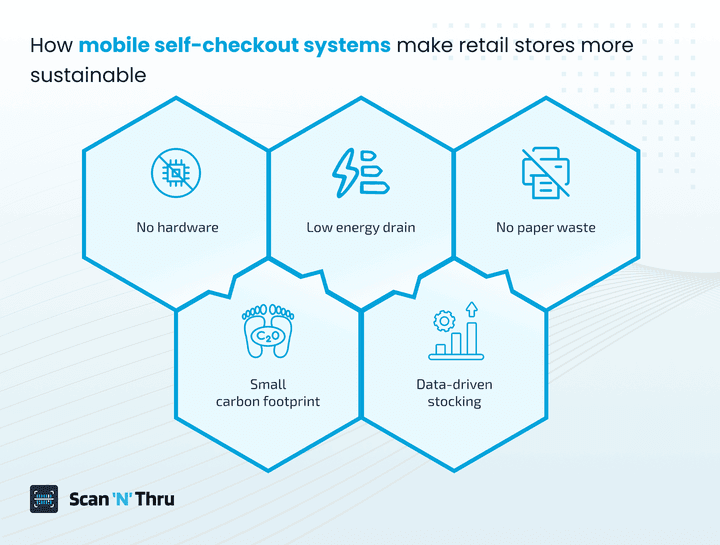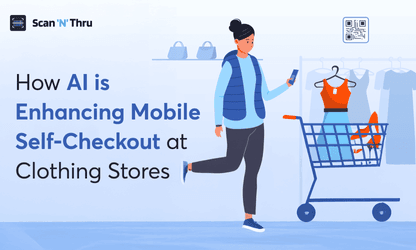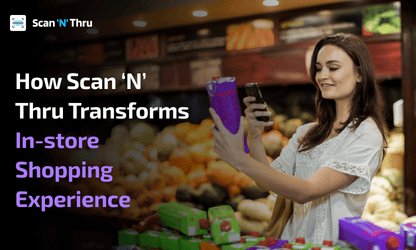Most retail waste isn’t in the bags customers carry out. It’s in the way stores operate behind the scenes.
From receipt paper to power-hungry kiosks and billing counters, traditional checkout systems quietly contribute to a large and largely invisible environmental footprint. The problem isn’t just inefficiency; it’s that this waste has been normalized.
But sustainability matters. And more and more customers are getting conscious about sustainable shopping.
Mobile self-checkout technology can help retailers like you make your business more sustainable. It doesn’t just remove friction from the in-store shopping experience; it removes waste from the retail equation and brings in a lot of efficiency.
But how? That’s what you’re going to know in this blog.
Let’s look closer at how mobile self-checkout systems are quietly shaping a cleaner and more sustainable future for retail stores.
Retail’s hidden waste problem
Not all environmental waste comes in packaging. A surprising amount is built into how retail stores are set up and run day to day.
More than just packaging
Paper and plastic flow freely through most stores—receipts, loyalty cards, printed flyers, plastic bags, barcode stickers.
Each of those seems small in isolation, but multiply it across thousands of customers a week, and the volume adds up fast. And it doesn’t end with materials, there’s also the issue of hardware.
Checkout counters, receipt printers, kiosks, payment terminals, wiring, and signage all require materials to build, ship, install, and maintain. Eventually, all of it becomes e-waste or landfill.
Power-heavy checkouts
Most self-checkout kiosks and traditional POS terminals are always on. They consume electricity, generate heat, and require maintenance.
And in stores with dozens of terminals, this can lead to higher cooling needs, higher power bills, which means a higher carbon footprint just to run the checkout process.
It’s an environmental cost that’s been accepted as standard. But it doesn’t have to be like that.
How mobile self-checkout systems bring sustainability to your store
Unlike traditional checkout systems, mobile-based self-checkout doesn’t require added infrastructure. It’s built to do more with less, and the environmental benefits come naturally.

No hardware needed
Mobile self-checkout apps live in your shopper’s smartphone. So, there’s no need for dedicated kiosks, scanners, terminals, or receipt printers.
That means no additional materials, no manufacturing, no installation, and no hardware to eventually dispose of.
You basically skip the clutter and the carbon footprint, without giving up control or speed.
Low energy drain
Since the customer is using their own device, the store doesn’t need to power any part of the checkout process.
There are no constantly active machines drawing electricity, no terminals to cool, and no maintenance schedules to manage.
The result is less power consumption, lower operational costs, and a lighter environmental footprint.
Digital receipts only
Thermal receipt paper (used for bills and receipts) can’t be recycled and often contains chemicals with poor solubility (BPA).
With mobile self-checkout apps, receipts are entirely digital. So, no printing, no rolls, no ink, no waste.
And for your customers, digital receipts make returns and records easier. It’s a rare case where the greener option is also the more convenient one.
Space efficiency
When you remove checkout counters, kiosks, and payment terminals, you're not just freeing up space in your store; you’re also avoiding the materials and energy needed to build and maintain them.
Smaller checkout footprint
Mobile-based self-checkout systems shrink the physical footprint of the checkout. That opens up more room for merchandising or movement, while also cutting down on wood, metal, and plastic used in store interiors.
For new store designs or retrofits, this can also lower construction costs and simplify floor planning, which is another quiet step toward sustainability.
Read more: Optimize Your Store Layout with Mobile Self-Checkout Solution
Smarter operations
It’s not just the physical materials; retail waste also comes from overproduction, unused promos, and inefficient stocking. Mobile self-checkout technology helps on that front as well.
Data-driven stocking
With real-time purchasing data coming from mobile self-checkout systems, retailers like you can better understand what’s moving and when.
This leads to more accurate ordering, less overstocking, and reduced spoilage or clearance markdowns.
Smart inventory is a hidden force in reducing waste, and mobile self-checkout helps power it.
No more printed promos
Flyers, posters, and shelf signs are often discarded after a short run. But with mobile self-checkout, you can push personalized offers directly to shoppers in the app. No paper, no clutter, no printing logistics.
And since the offers are targeted, they tend to be more relevant and more effective.
Sustainability that saves money
It’s easy to think of sustainability as a cost. But with mobile self-checkout, the opposite is often true. Here’s how:
Lower operating costs
No thermal paper for receipts. No maintenance-intensive machines. No kiosks to repair or replace. No added electricity bills from always-on systems. The cost savings are steady and significant over time.
A brand image that resonates
Customers notice the little things. When there’s no printer at checkout, when the receipt hits their inbox instantly, and when they breeze through the store without queuing, they see a brand that’s thoughtful and efficient. And increasingly, a brand that aligns with their values.
Being sustainable doesn’t just reduce costs. It builds credibility.
Final words: A simpler and greener way to run your store
Most sustainability efforts in retail focus on products or packaging. But mobile self-checkout offers a different path—one that’s operational, quiet, and built into the customer journey itself.
You eliminate waste without adding friction. You cut power use without slowing things down. You reduce your footprint while improving the experience.
So if you want to make your store more sustainable, then consider Scan ‘N’ Thru. It’s a mobile self-checkout solution built for modern retail—digital receipts, real-time data, loyalty integration, and zero in-store hardware. No lines. No printers. No unnecessary energy use.
If you're aiming to make your store more sustainable, then Scan ‘N’ Thru is the right fit.




